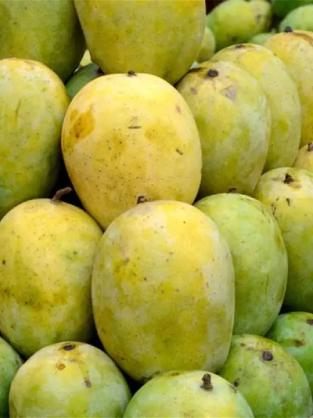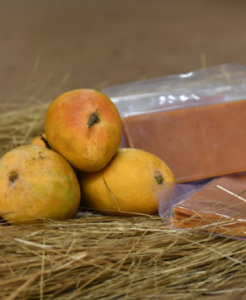Identifying Alphonso mangoes that have been ripened using calcium carbide or other chemicals can be challenging, but there are some signs and methods you can use to detect artificially ripened mangoes:
Visual Inspection
Uniform Colour: Naturally ripened mangoes usually have a mix of colours, including green, yellow, and sometimes a slight red blush. Mangoes ripened with chemicals like calcium carbide often have an unnaturally uniform yellow or orange colour.
Skin Texture: Artificially ripened mangoes tend to have smooth, flawless skin. Naturally ripened ones may have slight blemishes or spots.
Colour of the Stem: The stem of a naturally ripened mango is typically green. If the stem area is black or dried, it may indicate chemical ripening.
Touch and Feel
Firmness: Artificially ripened mangoes might feel firm even when they appear fully ripe. Naturally ripened mangoes will feel softer and yield slightly to pressure.
Ripening Pattern: In naturally ripened mangoes, ripening starts from the tip and spreads to the stem end. If the mango is uniformly soft all over, it might be chemically ripened.
Smell
Aroma: Naturally ripened Alphonso mangoes have a sweet, fragrant aroma. Chemically ripened mangoes often lack this natural, rich fragrance.
Taste
Flavor: Naturally ripened mangoes have a sweet, rich, and full flavor. Artificially ripened ones may taste bland, have an off-flavor, or lack the characteristic sweetness of Alphonso mangoes.
Scientific Testing
Chemical Test: There are laboratory tests available to detect the presence of chemicals like calcium carbide. These tests can determine the levels of acetylene and other residues left by artificial ripening agents.
Paper Test: A simple test involves wrapping the mango in a paper and leaving it overnight. If the paper has white or grey patches in the morning, it indicates the presence of chemicals.
Safety Tips
Source: Purchase mangoes from reputable sources, such as trusted fruit vendors, organic markets, or direct from farms known for natural ripening practices.
Washing: Thoroughly wash mangoes under running water before consuming to remove any surface residues.
Peeling: Always peel the mangoes before eating, as the chemicals are usually found on the skin.
Conclusion
While it’s not always easy to distinguish between naturally and artificially ripened mangoes, these methods can help you make a more informed choice. Opting for organic or trusted sources can reduce the risk of consuming chemically ripened fruits.













